Sunday was nothing new. OK, fine. Some of it was quite new.
Four-time defending champions Manchester City are now 11 points back of first place in the Premier League. Liverpool hadn't beaten them since before the 2022 World Cup, and hadn't beaten them this definitively since before they'd hired Jurgen Klopp in 2015 and maybe even before City were purchased by the Abu Dhabi royal family in 2008.
Sure, there were some heftier scorelines during the Klopp years, but City created only one above-average chance across the 90 minutes, and that only came from a once-in-a-season Virgil van Dijk giveaway after Liverpool were already leading 2-0. If we look only at the balance of chances created and conceded, City under Pep Guardiola have rarely, if ever, been dominated as badly as they were at Anfield.
Of course, Guardiola and City are used to getting dominated by one Liverpool player in particular: Mohamed Salah. The Egypt international scored or assisted for the sixth straight game against City -- and this time he did both. It's not just City, either. Only Alan Shearer has more goals (60) against the Premier League's Big Six than Salah (57), and only Shearer (88) and Ryan Giggs (80) have notched more goals+assists than Salah's 78.
If you had to choose one "clutch" player in the Premier League from the past decade, Salah would have to be it. But what about the rest of the league? Are there certain players who perform best in the most decisive moments? And if there are, does it tell us anything about what's likely to happen in the future?
First, let's define 'clutch'
Given the structure of the sport, the NBA has produced the most research -- and most hand-wringing -- about what it means to be "clutch." Since it's such a high-scoring sport, points scored earlier in the game certainly feel less meaningful than those that arrive later. Plus, basketball is the most individual of the team sports -- especially at the end of games. When the score is close and not much time is left, teams tend to feed the ball to their best player, move everyone else out of the way, and let them decide the outcome of the game on their own.
In fact, "clutch" is such an established part of basketball vernacular that the NBA's own website even has a full section dedicated to individual statistics in clutch situations, which they define as "possessions within the last five minutes of games when the score is within five points or fewer."
Gab Marcotti and Julien Laurens disagree over the current contract standoff between Liverpool and Mohamed Salah.
Unfortunately, soccer doesn't really work like that, but today we're basically searching for situations where the game feels like it's in the balance and where any action feels like it could determine the outcome. The NBA only reaches this point when there's a few minutes left on the clock, but part of the reason so many people watch the Premier League is that soccer games can be infused with this high-leverage uncertainty for the entire 90 minutes.
So, to land on our own definition of clutch, I think it makes sense to go broad. We want to look at all game situations when the score is within a single goal. If we take goal-scoring in particular, then we'd be looking at goals that either (A) tie the game, (B) take the lead, or (C) create a two-goal lead.
The last one might not feel clutch, but it is. If you've ever rooted for a team that have only got a one-goal lead, you know the emotional weight-lifting effect that comes from a two-goal cushion. Just ask Liverpool fans how much better they felt after Salah slotted home his penalty in the 78th minute on Sunday.
There's the old saying about how a two-goal lead is the worst lead in soccer. What I'm here to tell you: A two-goal lead is the best lead in soccer.
Who are the most clutch attackers in the Premier League?
Over the past three years, here's how the top 10 looks for most "clutch" goals, based on my definition:
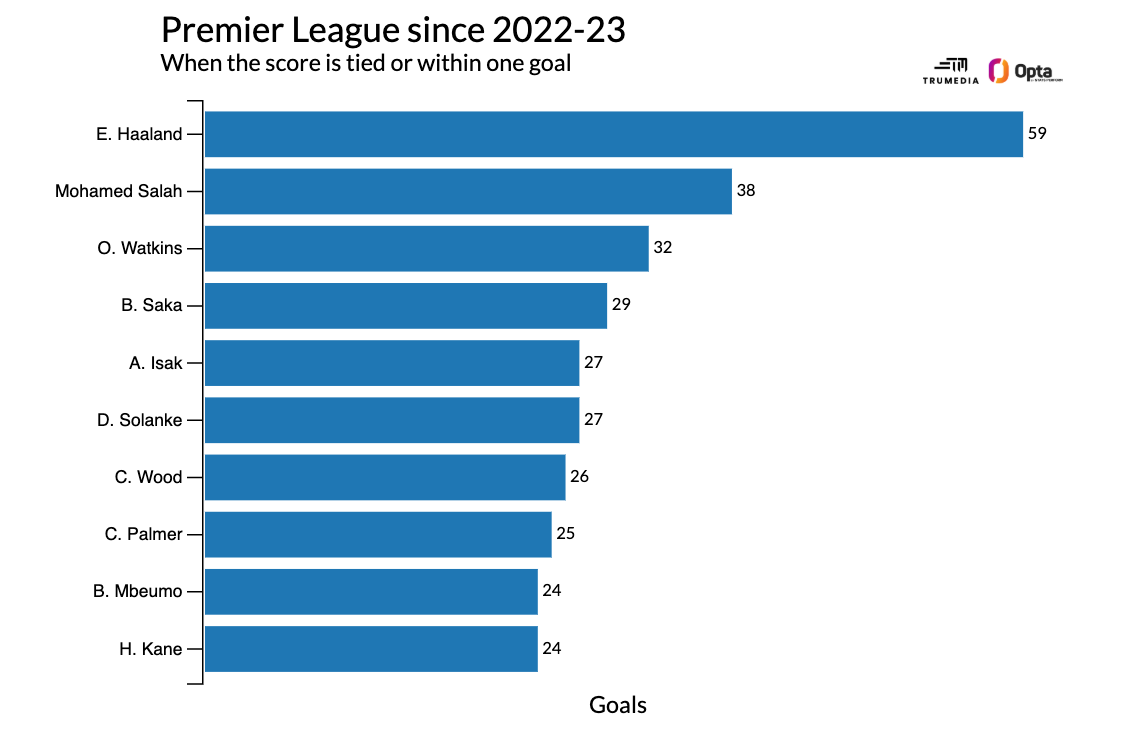
There's no real explanation needed here. These are the players who have kicked or headed the ball into the goal the most times since 2022-23 when the games have been close. City striker Erling Haaland has done it most often, followed by Salah. We're simply awarding these players with full credit for converting their opportunities, whether a penalty or a long-range shot, and creating a new game state.
For other stats, though, it gets a little trickier. It's not like only goal scorers can be "clutch," but if we want to measure, say, "clutch" passing, then assists don't really fit the ideal. To register a clutch assist, you'd need a clutch goal scorer to also convert your pass into a goal.
We typically view "clutch" as some kind of genetic trait attributed to individuals rather than collectives. Outside of maybe Real Madrid, clutchness is rarely seen as something that a group of people can conjure up by working together. I'd argue that it's more likely for a group of people to consistently be able to build off each other and function on a higher plane in decisive moments than for select individuals to summon inner strength, over and over again. But for now we'll stick closer to the traditional notion of clutchness.
So, for passing, we'll look at expected assists. In other words, who is creating the best chances, regardless of what their teammates are doing once they take the shots? Here's the top 10:
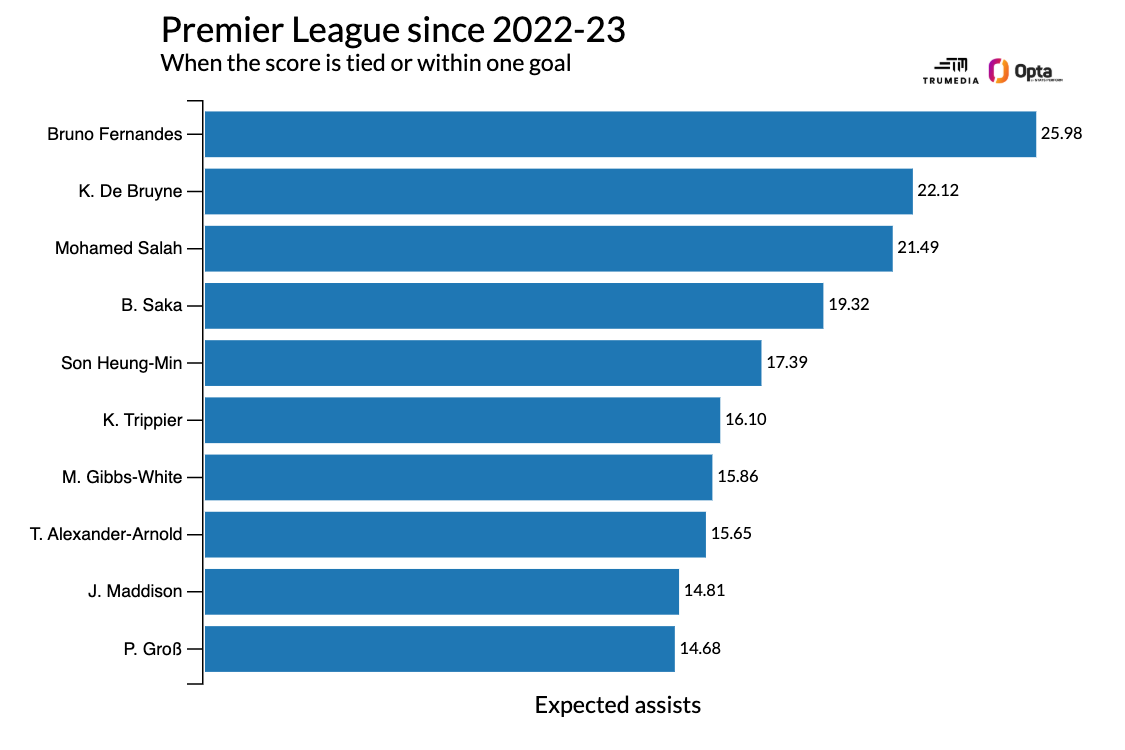
Now that we're through these two categories, perhaps you've noticed that there are only two players on both lists: Salah, and the player I referred to earlier this year as the next Salah, Arsenal forward Bukayo Saka. So let's combine both statistics and create a list of the most productive attackers in clutch moments over the past three seasons:
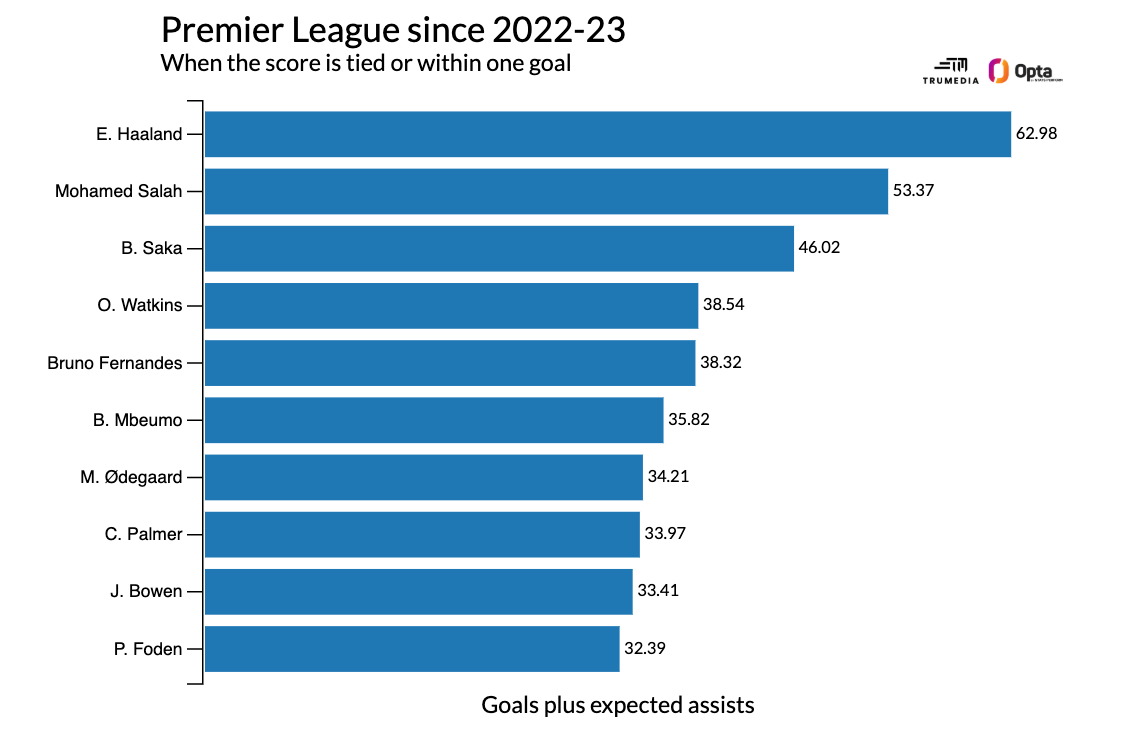
Here, Haaland is in his own tier, followed by Salah in his own tier, followed by Saka in his own tier, followed by everyone else.
Are there clutch midfielders, defenders and goalkeepers too?
Part of the reason there's such an obsession around "clutchness" in sports is that the moments themselves seem so stark. The game is on the line, a player either succeeds or fails, and then he's either cold-blooded or a choker.
Plus, it's way easier for fans and analysts to fall back on simple, emotional explanations for what happened. Why try to break down the comprehensive system interactions and collective efforts that led to both of these moments, and every moment before them in the same game, from occurring when you can just say that a player succeeded because they "have got that dog in them," or that they failed because they just don't have what it takes?
Within this framework, midfield and defensive play would seem to evade "clutchness" because effective midfield and defensive play are about low-value actions being completed at an incredibly high rate over and over again. But that doesn't mean that defenders and midfielders can't have massive impacts on matches when the score is close.
First, let's look at possession passing.
To determine the value, we're going to use Opta's expected possession value model (xPV), which it says "measures the probability that the team in possession will score during the next 10 seconds." We can then see how much every action on the field increased or decreased the goal-scoring probability in a given match. And so for this part, we'll only look at passes that were played from outside the attacking third, but ended inside the attacking third.
I have access to this data only going back to last season, so here's the top 10 since the start of the 2023-24 campaign:
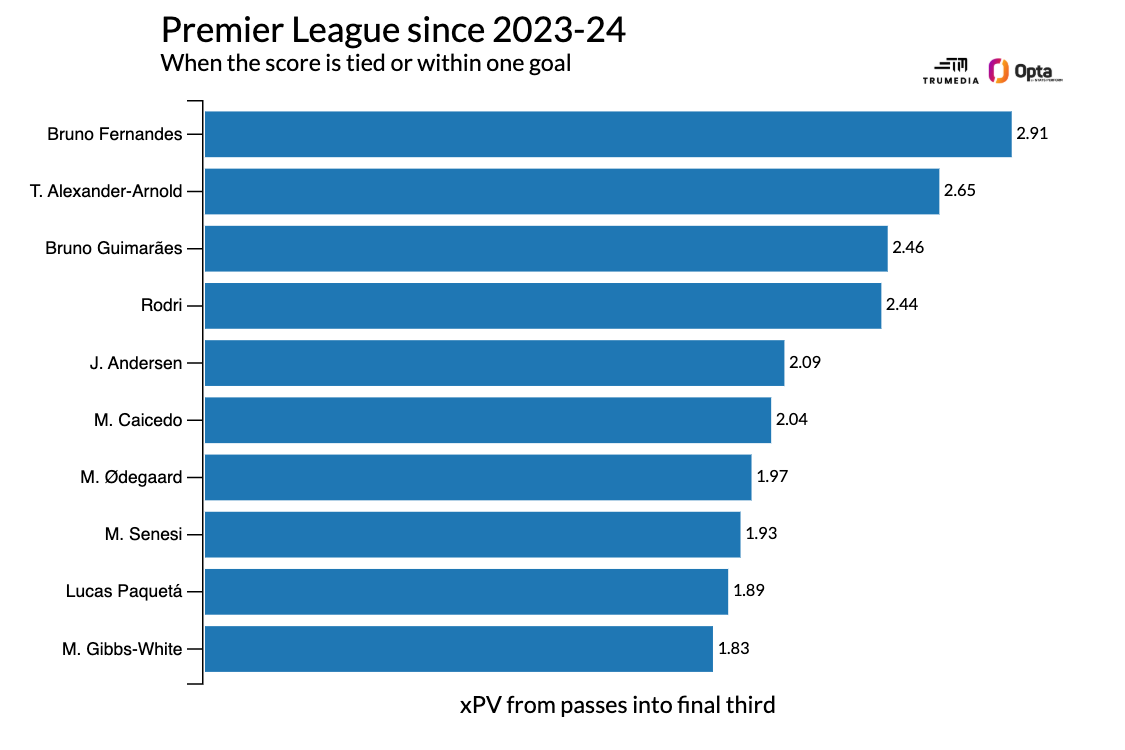
For an example of what a particularly high-value pass in one of these situations might look like, check out Trent Alexander-Arnold's ball to Darwin Núñez while Liverpool were trailing Arsenal 2-1 at the Emirates earlier this season:
To get a sense of who is doing the most on the defensive end when games are close, we can use xPV to look only at tackles, interceptions, clearances, blocked passes, and fouls committed. Here's that top 10:
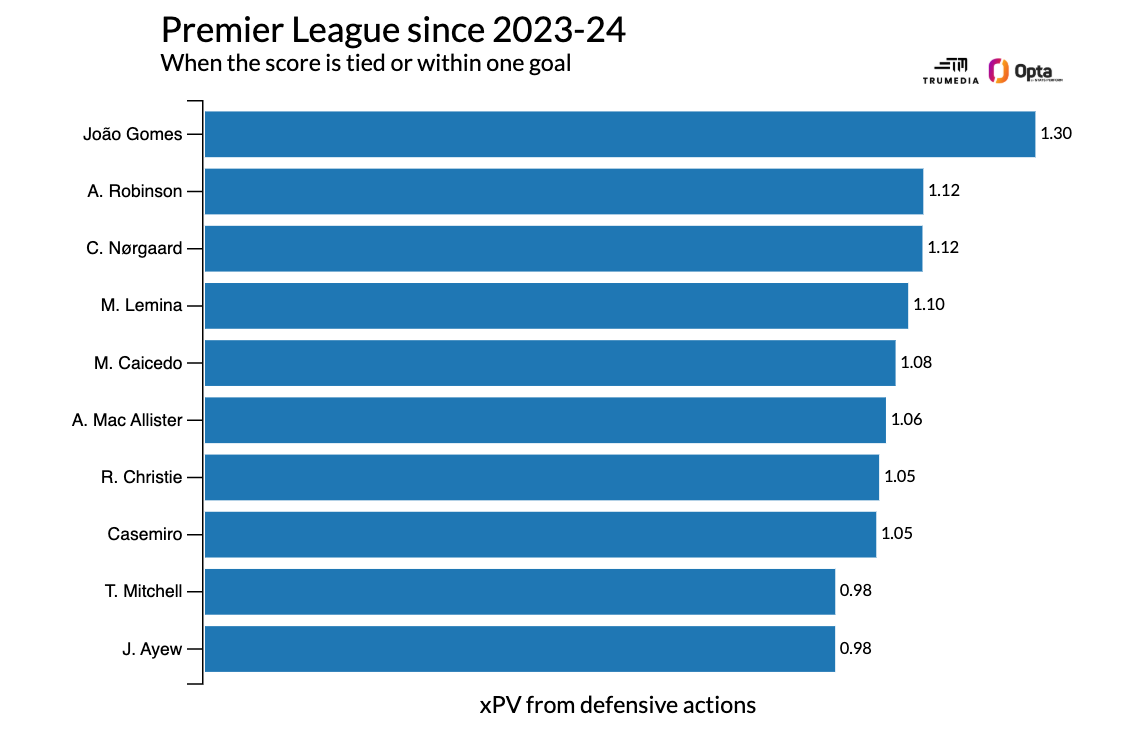
Now, this is mostly players on bad teams because those players have more opportunities to make plays without the ball. But both Liverpool's Alexis Mac Allister and Chelsea's Moisés Caicedo stand out because they're on two of the better, higher-possession teams in the competition. Caicedo, too, is the only player to appear on both this list and the possession-passing top 10. I keep saying this, but it's not a coincidence that Brighton had their best-ever season when they had both of these guys in the same midfield.
Lastly, we can see which keepers have been the most effective in close-game moments. We'll first look at the number of goals the average keeper would be expected to concede based on the location of shots faced -- both from where the shot was attempted and where it ended up on the goal frame. And then we'll compare it to the number of non-own goals conceded.
Here's the top 10:
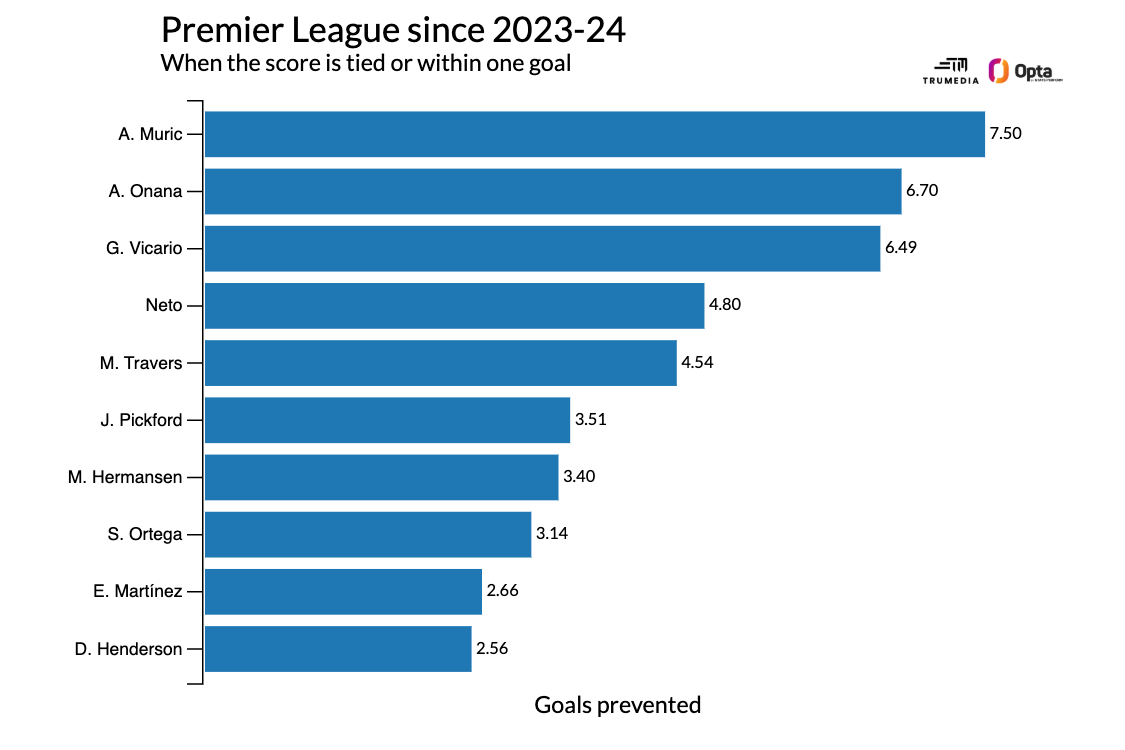
Might Burnley still be in the Premier League had Arijanet Muric been their keeper for all of last season and not just for the past couple of months? Now behind completely different personnel and tactics with Ipswich this season, he's still conceding significantly fewer goals than expected. He's also a fantastic cross-claimer and an active sweeper-keeper. Oh, and he's only 26.
If he keeps it up, expect a couple of big clubs to come calling for a transfer this summer.
So what does it all mean?
Mainly, the most clutch players are also "the best players."
Outside of a jaded few, there aren't many people who would disagree with the idea that Haaland, Salah and Saka have been the three best attackers in the Premier League over the past three seasons. All of the other contenders either haven't been healthy (Kevin De Bruyne) or haven't been playing in the Premier League (Cole Palmer, Harry Kane) for all of the three seasons we've examined.
Maybe this is the downside of using a broad definition to define clutchness. After all, the most common game state is an even scoreline, and the second-most common is a one-goal lead or one-goal deficit. So why would any of this be all that different than just looking at the leaders in any given stat, no matter the score?
What if we just look at the final 15 minutes of matches, within the same scoreline subset? Here's the top 10 for the same combined attacking metric we used above:
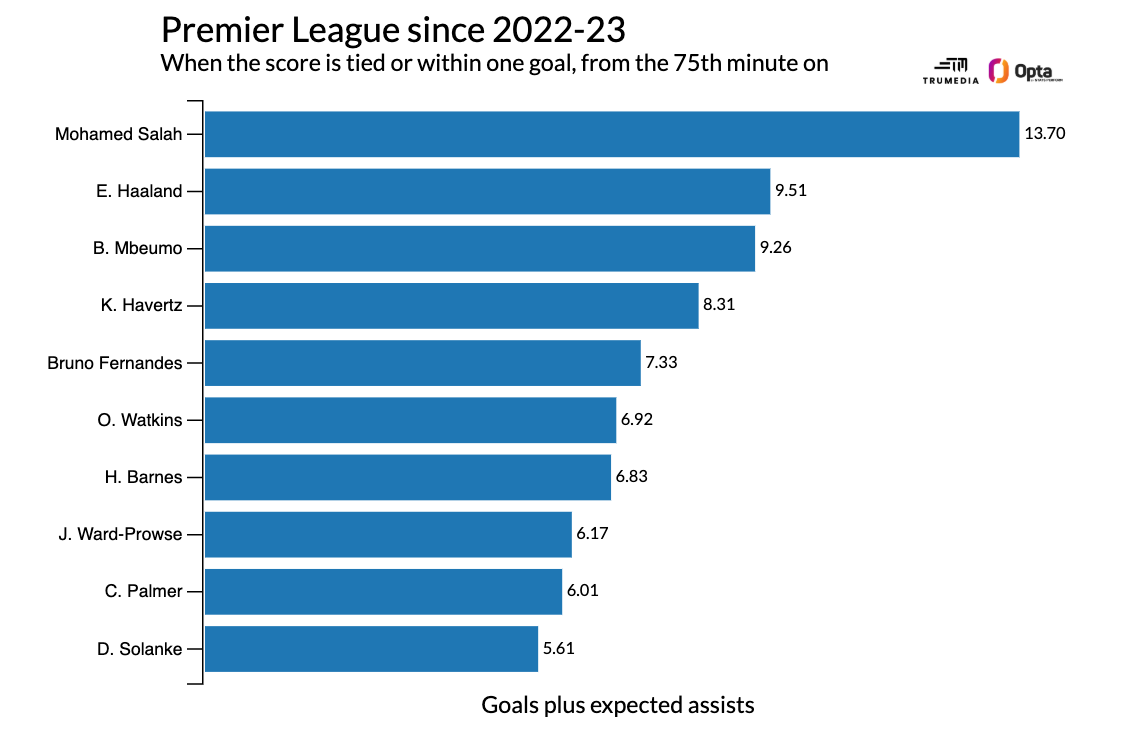
What's most notable: Salah leaps all the way up to first, and by a wide margin. And at the same time, Saka falls completely out of the top 10. It's not that bad -- he's only 11th -- but his numbers are nearly identical to a player very few people would argue is clutch: Liverpool's Núñez.
The problem here is the same problem with so much in soccer. There are so few goals that any time you try to zero in on a specific part of the game, you're ignoring so much relevant data.
While Salah clearly does deliver in big moments, a big reason why he leads this new list is that Liverpool have been significantly worse than Arsenal and Manchester City over the past three seasons combined. In other words, he had way more opportunities to break a deadlock, put a game to bed or tie the score in the final 15 minutes than either Haaland or Saka, because their teams were more likely to already be up by two or more goals. And as the earlier analysis suggests, Haaland and Saka were the two players most likely to get them there.
For similar reasons, much of the research into "clutchness" across other sports ends up being frustratingly vague or highly contingent on whatever parameters are used to define the term. The major breakthrough, instead, came from a twist of the lens -- a slightly new way to think about what excellence in high-pressure moments actually means.
To be clutch isn't to take your performance to an even higher level when the game is in the balance. Rather, it's to be able to maintain your normal level of performance during these high pressure moments.
Now, you might have looked at Salah's missed breakaway against Manchester City on Sunday or his missed penalty against Real Madrid last week and thought, "Yikes, he choked." But ultimately, he finished the week that featured Liverpool's two biggest games of the season with a goal and an assist. That's 1.0 goals+assists per game -- or exactly what he's averaged across his entire Liverpool career.
